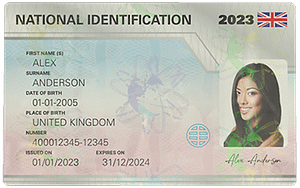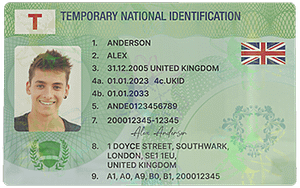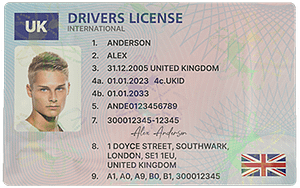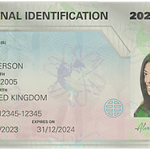Introduction
The concept of identity verification has been around for centuries, and with it, the existence of fake identity – related documents. Fake ID cards, in particular, have a long – winding history that spans across different civilizations and time periods. This article will explore the development of fake ID cards from ancient times to the present day, shedding light on the reasons behind their creation and the methods used to produce them.
Fake ID Cards in Ancient Times
In ancient civilizations, identity was often associated with social status, citizenship, and access to certain privileges. For example, in ancient Rome, citizens carried tokens or insignia that represented their status. These could be considered early forms of identity documents. However, there were also instances of forgery. Criminals or those trying to gain unauthorized access to certain areas or privileges might create counterfeit versions of these tokens.
The ancient Egyptians also had a system of identification. They used seals and amulets that could be used to identify individuals or their property. Counterfeiting these seals was not unheard of, especially when there were valuable goods or access to restricted areas at stake. The methods of forgery in these ancient times were relatively primitive. Forgers might try to replicate the design of a seal or token by hand – carving or using simple molds.

In ancient China, during the feudal dynasties, there were identity – related documents for officials and some citizens. For example, the “Tao Fu” was a kind of identity certificate for soldiers. There were also cases of counterfeiting these documents, mainly by skilled craftsmen who could imitate the calligraphy and seals on them. These forgeries were often used for illegal activities such as avoiding military service or gaining access to official positions fraudulently.
The Middle Ages and Fake ID – like Documents
During the Middle Ages in Europe, guilds and religious orders issued identity – like documents to their members. These documents were used to prove membership, which often came with certain rights and privileges. For example, a member of a powerful guild might have the right to trade in a particular area or practice a specific craft. Counterfeiting these guild or religious documents was a serious offense, but it still occurred.
Forgers in the Middle Ages had to be quite skilled as these documents often had elaborate designs, seals, and signatures. They might use techniques such as tracing, carefully imitating the calligraphy, and creating fake seals. These fake documents were sometimes used by individuals who wanted to gain access to the benefits associated with a particular guild or religious order without proper authorization. For example, a non – member might try to obtain a fake guild document to gain entry into a market where only guild members were allowed to trade.

At the same time, in the Islamic world, there were also identity – related documents for travelers, merchants, and scholars. These documents were important for safe passage through different regions and for conducting business. Forgery of these documents was also a concern, especially in areas with high levels of trade and movement of people. Forgers would try to replicate the script, seals, and other identifying features to create fake travel or merchant documents.
The Renaissance and the Evolution of Identity Documents
The Renaissance period saw significant advancements in art, technology, and printing. These advancements also had an impact on the creation and forgery of identity documents. With the invention of the printing press, it became easier to produce documents in large quantities. However, it also made it easier for forgers to create fake ID – like documents.
Governments and institutions started to issue more formal identity documents during this time. For example, passports began to take on a more recognizable form. Forgers now had to deal with more complex elements such as watermarks, which were starting to be used in paper production to add an extra layer of security. Some forgers would try to create fake watermarks by using various techniques, such as pressing a dampened object with the desired pattern onto the paper. However, these attempts were often detectable by trained eyes.

As the concept of citizenship became more defined, identity cards for citizens also started to emerge in some regions. These cards were used to prove a person’s identity and citizenship status. Forgers were constantly trying to keep up with the latest security features of these cards, using tools such as engraving devices to replicate the details on the cards.
The Modern Era of Fake ID Cards
In the 19th and 20th centuries, identity cards became more standardized and widespread. National identity cards were issued in many countries for various purposes, such as for voting, accessing social services, and travel. With the growth of organized crime and the demand for fake ID cards for illegal activities such as underage drinking, fraud, and illegal immigration, the production of fake ID cards became a more sophisticated business.
Advancements in technology, such as color printing, holography, and magnetic strips, were incorporated into identity cards for security purposes. However, forgers also adapted. They started using high – quality color printers, laser cutters, and other advanced equipment to create fake ID cards that were almost indistinguishable from the real ones at first glance. Some even went as far as to replicate holographic elements using techniques such as photomasks and laminating processes.
The internet has also played a significant role in the modern fake ID card market. There are numerous websites that offer to produce fake ID cards for a fee. These websites often use sophisticated marketing techniques to target individuals, especially young people looking to obtain fake IDs for underage access to bars and clubs. Law enforcement agencies around the world have been working hard to combat this online trade, shutting down illegal websites and arresting those involved in the production and distribution of fake ID cards.
Security Features and Counter – Measures Against Fake ID Cards
To combat the problem of fake ID cards, governments and issuing authorities have been constantly improving the security features of identity cards. One of the most common features is the use of holograms. Holograms are three – dimensional images that are difficult to replicate without specialized equipment. They often contain unique patterns and images that are specific to the issuing country or organization.
Another important security feature is the use of microprinting. Microprinting involves printing very small text or patterns on the ID card. These are often invisible to the naked eye but can be easily detected with a magnifying glass. Forgers find it extremely difficult to replicate microprinting accurately.
Biometric features, such as fingerprints, facial recognition, and iris scans, are also being increasingly incorporated into identity cards. These features provide a more accurate and unique way of identifying an individual. Biometric data is stored on the ID card in a secure format, making it very difficult for forgers to replicate.
Additionally, watermarks and security threads are still widely used. Watermarks are embedded in the paper during the manufacturing process and are visible when the card is held up to the light. Security threads are thin strips of material that are also embedded in the card and can have various security features such as holographic patterns or text.
Common Problems and Solutions
1. Detection of Low – Quality Fake ID Cards
Problem: Low – quality fake ID cards are often produced using basic equipment and materials. They may have obvious signs of forgery such as poor print quality, incorrect colors, or misspelled words. However, in some cases, they can still deceive inexperienced bouncers or ID checkers, especially in busy environments.
Solution: Provide comprehensive training to those responsible for checking ID cards. This training should include how to identify the basic security features of a real ID card, such as holograms, watermarks, and microprinting. They should also be taught to look for common signs of forgery in low – quality fake ID cards, such as uneven edges or inconsistent font styles. Additionally, using simple tools like magnifying glasses can help in detecting microprinting and other small details that may be incorrect on a fake ID.
2. Detection of High – Quality Fake ID Cards
Problem: High – quality fake ID cards are becoming increasingly sophisticated, with forgers using advanced technology to replicate security features. These fake ID cards can be very difficult to distinguish from real ones, even for trained professionals. They may have accurate holographic elements, proper color – matching, and correct microprinting.
Solution: Law enforcement agencies and ID – checking organizations should invest in advanced detection equipment. For example, there are specialized machines that can analyze the magnetic strips on ID cards, detect the authenticity of holograms, and even read biometric data if present. Regularly updating the knowledge base of ID checkers about the latest techniques used by forgers and the security features of new – generation ID cards is also crucial. Collaboration between different countries and regions to share information about fake ID trends can also help in the detection of high – quality fake ID cards.
3. Online Trade of Fake ID Cards
Problem: The internet has made it easier for fake ID card producers to reach a wider audience. There are numerous websites that openly offer to produce fake ID cards, often with detailed instructions on how to order and pay. These websites are difficult to shut down completely, as they may operate from different countries and use various techniques to avoid detection.
Solution: Governments and law enforcement agencies need to collaborate on an international level to track down and shut down these illegal websites. This may involve working with internet service providers, payment processors, and other relevant parties. Stricter laws and penalties for those involved in the online trade of fake ID cards should also be enforced. Additionally, public awareness campaigns can be launched to educate people, especially young people, about the risks and legal consequences of purchasing fake ID cards online.
4. Underage Use of Fake ID Cards
Problem: A significant portion of fake ID card use is by underage individuals who want to gain access to age – restricted places such as bars, clubs, and casinos. This not only violates the law but also poses risks to the health and safety of the underage individuals, as well as to the establishments that serve them.
Solution: In addition to the above – mentioned detection and law – enforcement measures, educational campaigns targeted at young people can be effective. These campaigns should highlight the legal and social consequences of using fake ID cards, as well as the potential health risks associated with underage drinking. Establishments should also be encouraged to implement strict ID – checking policies and to train their staff to be more vigilant in detecting fake ID cards used by underage individuals.
5. Identity Theft through Fake ID Cards
Problem: Fake ID cards can also be used for identity theft. Criminals may create fake ID cards using the personal information of others to open bank accounts, obtain credit cards, or commit other forms of fraud. This can cause significant financial and personal harm to the victims.
Solution: Strengthening identity verification processes in various institutions is essential. This includes using more advanced biometric authentication methods, cross – referencing identity information with multiple databases, and implementing strict security protocols for handling personal information. Victims of identity theft should also be provided with easy – to – follow procedures for reporting the crime and recovering their identity. Law enforcement agencies should prioritize the investigation and prosecution of identity – theft cases related to fake ID cards.


